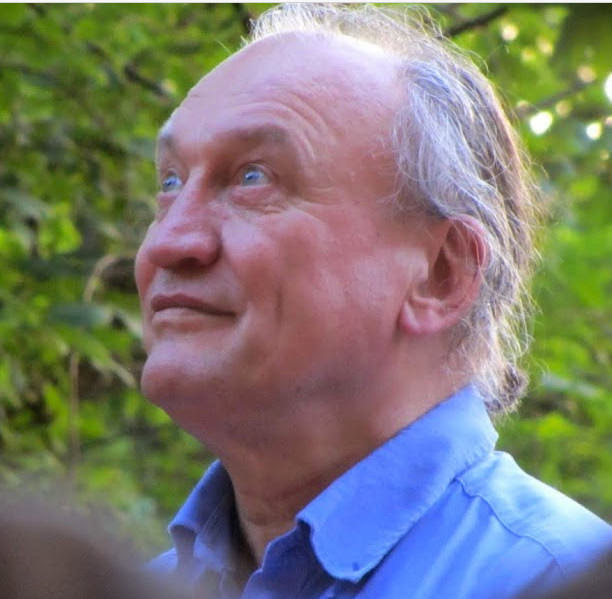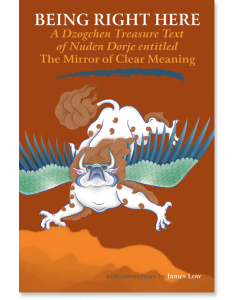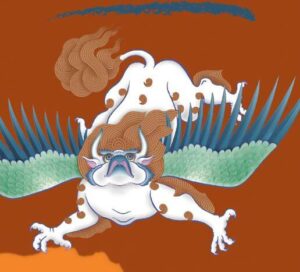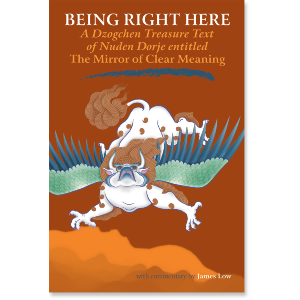| The following article is from the Winter, 2004 issue of the Snow Lion Newsletter and is for historical reference only. You can see this in context of the original newsletter here. |
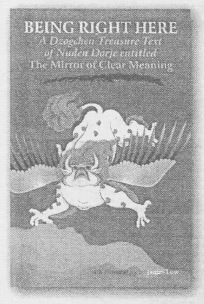
Tremendously accessible, fresh, and deep explication of the view and essential meditation of Dzogchen, the practice of non- dual experience. The wonderful commentary is based around the treasure text of Nuden Dorje, a text that is in the Men ngag style, a personal instruction distilling the author's own realization.
The commentary explains pivotal practices and addresses difficulties that arise in meditation. It provides both an expansion of the traditional concepts in the text and an examination of how they can function in contemporary life.
JAMES LOW has been a student of the fourth incarnation of Nuden Dorje for 30 years. He has translated numerous texts with Chhimed Rigdzin. He works as a consulting psychotherapist in a London hospital, and teaches dzogchen meditation around the world.
Below is an excerpt from Being Right There.
Shine—Training of Concentration
We have to start to be able to separate what is occurring from the one who is aware of what is occurring. In order to do that we have to develop a focused concentration or mindfulness so that our attention doesn't flutter and flow into the constant stream of arisings. If you are a beginner in meditation and you find that your mind is wandering a great deal, it is necessary to practice with a simple focus in order to develop the capacity to stay calm (shine, ZhigNas). In order to practice clear investigation we have to set up laboratory conditions in which we can hold the frame and limit the number of variables. There are simple ways of helping the mind to focus. We can focus visually on an object outside of ourselves. We can focus on the breath or we can focus on something we imagine.

In Buddhist meditation I we need to recognise our many assumptions about the nature and status of our thoughts, feelings and so on and learn to bracket them in order to look freshly at what is actually there.
Generally speaking the external objects are divided in neutral objects, emotionally invested objects and symbolically enriched objects. As an example of the first you could find a small pebble rounded in shape with not a very interesting colour or pattern, just a simple shape to fix your attention on. You place it at a height about level with your heart at about an arms length from you. You allow your attention to rest on it. You could also use the flame of a candle or a butterlamp but the flickering may be unhelpful. In the early days of Buddhist practice they used to make a little disk with clay and put it on a stick, placed at the previously mentioned height and distance.
Or you can use an object which has an emotional impact. In particular people traditionally use a small statue of the Buddha .You could also use a statue of Padmasambhava so that your own faith and devotion toward this image acts as a strengthening factor for the focusing of attention on it.
Or you can use a symbolic object like the letter A' or the letter Hung'. Usually people use the letter A', often white on a dark blue background, and supported by a stick as previously. The distance the object is away from you needs to change depending on the temperature. If it is a very hot day and you are getting sleepy then if the object is too close to you and is causing an intensity of gaze this will increase the likelihood of distraction. So use the distance to the object as a method for helping your practice. With the view of dzogchen there are many choices and it is up to you to investigate what works for you.
The answer to the problem of suffering, the real nature of your own mind, will not arrive one day with the postman. You yourself will have to take the teaching and investigate it, so that you have the definite experience. Others give us concepts or some kind of enriched frame, which can optimise the possibility of experience, but we ourselves have to be hungry to gain that experience. In dzogchen self-responsibility is privileged very highly. There is very little stress on rules and vows and regulations. The main factor is to understand the principles of how the mind becomes clear and how the mind becomes obscured and then to learn a range of practices, which you can use to keep yourself in clarity.
Where do the Arisings come from?
In looking into the nature of the mind, firstly make sure that you have enough stability and focus in order to be able to do the looking. If you don't have that, do some of these preliminary practices of focusing on the object that have just been described.
When we do shine practice, for example focusing on the breath, keeping the awareness on the upper lip and feeling the keeping the awareness on the diaphragm as it moves in and out, we have a sense that our mind wanders off. Then we have to catch it and bring it back to the point of focus.
So we start with a simple object that is easy to clarify; something outside ourselves or our own breath and then on the basis of this object is the primary focus of attention. We suddenly become aware that our mind has wandered and so very gently we just catch our attention and bring it back without any blame or faulting to the object of attention. When we have that kind of focus established we can sit relaxed and then watch this flow of stuff that is coming into our experience.
In my experience it is easier for most people to start with the question: Where do thoughts come from, where do they stay and where do they go to? We focus on what it is that is occurring in our mind and try to get a sense of where it comes from. How did the stuff get into our mind? After all, we are sitting here quietly inside our little skin bag, and all this stuff is coming in. But when we look for where the thought comes from, we are not trying to find out what was the thought that was there before this thought. Otherwise we trace the lineage of samsara. And as it always says: Samsara is without beginning. This would take us a very long time. We are not looking at where the thought comes from within the dimension of thought. We are stepping back and seeing the thought coming and having a sense of it when we ourselves are not resting on or identified with thought. In order to do this, the one who is looking has to be very relaxed and is themselves being teased out and gradually you experience an enormous loosening or relaxing of presence.
We apply the same approach to exploring where thoughts rest, Thought' in this context includes emotions, feelings and sensations. Thoughts' is being used as a short form for whatever is arising in our experience. We are sitting quietly. Where is this stuff staying? Where does it stay? It is in my mind but what is holding it up? So you have a lot of investigation to do. And then explore where do thoughts, feelings, emotions go to.
Because it is as if we have been sitting in a very dark room which is very busy for a long time. Many things have been going on but we have never really wondered what they are. We have just taken it for granted: Oh, this is a thought. Oh yes, they come and go. Just as in the phenomenological method that was developed by Husserl the key point here is the ability to bracket off assumption so that you can see more clearly what it is actually presenting itself. In Buddhist meditation we need to recognise our many assumptions about the nature and status of our thoughts, feelings and so on and learn to bracket them in order to look freshly at what is actually there.
It might be interesting to sit outside. Relax and take up these questions and explore for yourself what is your way into this and you will start to feel the pressure of assumptions and feel the urge to be distracted and to fall into the flow of thoughts. Then if you think how many hours, months and years of your life you have spent looking at things, being fascinated by things that have now passed away, then how wonderful to spend even five minutes looking into the nature of your own mind.
Not to be busy
Tibetans say that once upon a time all the yaks that live in Tibet were living in India as water buffalo. It was very, very hot in India so some of them decided if they were to keep walking to the north they would get to a place that would be nice and cool. So they climbed up in the mountains, and as they were climbing their hair started to grow. Because of this the water buffalo in India often turn their head and look out expectantly and they are waiting for their brothers who have wandered off. In a similar way at one time all the buffalo of samsara and nirvana were living together and one day some of them wandered off and came into samsara. They keep looking around to see who else is there and where the other half is, because the basic quality of our ordinary sense of self is that it is very lonely.
Something is missing in our lives and we don't quite know what it is, but we keep looking and looking to find this missing part. We can look for it in terms of possessions, we can look for it in terms of the form of our body, trying to change it through dieting or hair style or whatever. You can look in terms of friends. Anything. And this keeps us very, very busy. Sometimes the busyness can be very exhausting, but when we stop then we feel lonely. So we get busy again. Dharma is very helpful here if you want distraction because there are many kinds of ways to be busy Ln the dharma. You can focus on having lots of dharma possessions. You can focus on learning the text by heart, on the mantras and mudras, on serving the tsog, on doing meditations. There is always something to be busy with.
In Tibet many, many people practiced dharma but not so many seem to get enlightened. There are many kinds of dharma and if we practice in a way that doesn't focus on the essential point but on secondary and tertiary levels it is easy to get lost. It is really important, given that we have limited time, to focus on what is essential. Many people when they get a plate of food will eat the things they don't like so much first and leave the special thing to the end. But when when we apply this to life we can make a big mistake. The time for deep practice is now. You can learn all about Padmasambhava and what his clothes mean and what his hair style means but if you don't know the nature of your own mind then knowledge about Padmasambhava is just some more concepts.

